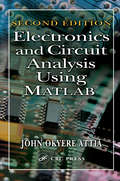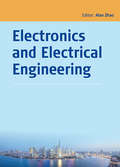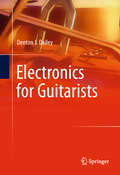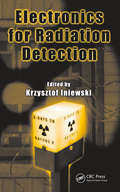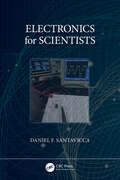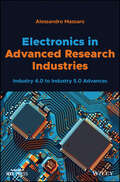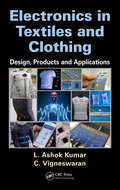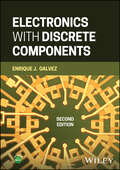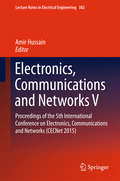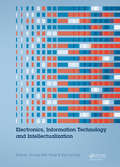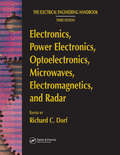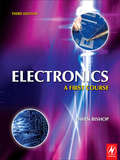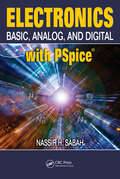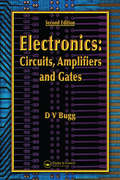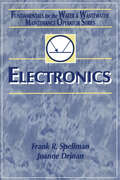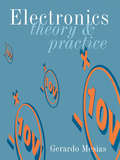- Table View
- List View
Electronics and Circuit Analysis Using MATLAB
by John Okyere AttiaThe use of MATLAB is ubiquitous in the scientific and engineering communities today, and justifiably so. Simple programming, rich graphic facilities, built-in functions, and extensive toolboxes offer users the power and flexibility they need to solve the complex analytical problems inherent in modern technologies. The ability to use MATLAB effectively has become practically a prerequisite to success for engineering professionals. Like its best-selling predecessor, Electronics and Circuit Analysis Using MATLAB, Second Edition helps build that proficiency. It provides an easy, practical introduction to MATLAB and clearly demonstrates its use in solving a wide range of electronics and circuit analysis problems. This edition reflects recent MATLAB enhancements, includes new material, and provides even more examples and exercises. New in the Second Edition:Thorough revisions to the first three chapters that incorporate additional MATLAB functions and bring the material up to date with recent changes to MATLAB A new chapter on electronic data analysis Many more exercises and solved examples New sections added to the chapters on two-port networks, Fourier analysis, and semiconductor physics MATLAB m-files available for downloadWhether you are a student or professional engineer or technician, Electronics and Circuit Analysis Using MATLAB, Second Edition will serve you well. It offers not only an outstanding introduction to MATLAB, but also forms a guide to using MATLAB for your specific purposes: to explore the characteristics of semiconductor devices and to design and analyze electrical and electronic circuits and systems.
Electronics and Electrical Engineering: Proceedings of the 2014 Asia-Pacific Electronics and Electrical Engineering Conference (EEEC 2014), December 27-28, 2014, Shanghai, China
by Alan ZhaoThe 2014 Asia-Pacific Electronics and Electrical Engineering Conference (EEEC 2014) was held on December 27-28, 2014 in Shanghai, China. EEEC has provided a platform for researchers, engineers, academicians as well as industrial professionals from all over the world to present their research results and development activities in Electroni
Electronics and Instrumentation for Audiologists
by Paul James MoserThis volume is the first electronics and instrumentation for audiology text and provides information on the variety of applications of electronics and audiology that are often omitted from science and engineering books. The book explains the operation of various instruments used in audiology applications, and it contains pertinent equations, numerical examples, and practice exercises. It also addresses fine details of electronics and instrumentation not often found in other texts, including the difficult concepts of electrical impedance and acoustic impedance. Additionally, it incorporates precise language and high quality drawings to explain electronic concepts clearly and accurately. This textbook is ideal for graduate-level courses on applications of modern electronics in both hearing aids and diagnostic instruments. It is an indispensable resource for students and researchers of audiology, and a valuable reference for practicing audiologists.
Electronics for Artists: Adding Light, Motion, and Sound to Your Artwork
by Simon Quellen FieldWith today's modern technology--LEDs, servomotors, motion sensors, speakers, and more--artwork can incorporate elements of light, sound, and motion for dramatic effects. Author and educator Simon Quellen Field has developed a primer for creative individuals looking for new ways to express themselves though electronically enhanced art. Following step-by-step examples of basic circuitry and programming, readers can develop the skills necessary to enhance their works of art. The book also features art projects to try, including a bouquet of glowing flowers, an LED metronome, a talking computer, a sensile robot, and a simple wheeled robot. A variety of artistic works created by Field's students and based on these open-ended lessons are also included to provide creative sparks for the readers. For those interested in programming their circuits, Field explores the basics of Energia, a free software package, and provides simple programs to create flashing light patterns, computer controlled motors, and LCD text displays.
Electronics for Guitarists
by Denton J. DaileyThis book is written for the guitarist that would like to know how transistor and vacuum tube-based amplifiers, and how various circuits effects work. The main thrust of the material is old school analog circuitry, including heavy coverage of discrete transistors and diodes, classical filter circuits, and vacuum tube-based amplifiers. This book should be useful to electronics hobbyists, technologists and engineers that are interested in guitar-related applications.
Electronics for Guitarists
by Denton J. DaileyThis updated, augmented third edition is aimed at hobbyists, students, engineers, and others who would like to learn more about the design and operation of electronic circuits used by guitarists. This book presents accessible qualitative and quantitative descriptions and analysis of a wide range of popular amplifier and effects circuits, along with basic design techniques allowing the reader to design their own circuits. The new edition further includes several additional circuits and topics suggested by readers of the previous editions, including noise gates, analog multipliers, the effects loop, and additional tube amplifier design examples.
Electronics for Kids: Play with Simple Circuits and Experiment with Electricity!
by Oyvind Nydal Dahl<P>Why do the lights in a house turn on when you flip a switch? How does a remote-controlled car move? And what makes lights on TVs and microwaves blink? The technology around you may seem like magic, but most of it wouldn’t run without electricity.Electronics for Kids demystifies electricity with a collection of awesome hands-on projects. <P>In Part 1, you’ll learn how current, voltage, and circuits work by making a battery out of a lemon, turning a metal bolt into an electromagnet, and transforming a paper cup and some magnets into a spinning motor. <P> In Part 2, you’ll make even more cool stuff as you: <br>–Solder a blinking LED circuit with resistors, capacitors, and relays <br>–Turn a circuit into a touch sensor using your finger as a resistor–Build an alarm clock triggered by the sunrise <br>–Create a musical instrument that makes sci-fi sounds. <P>Then, in Part 3, you’ll learn about digital electronics—things like logic gates and memory circuits—as you make a secret code checker and an electronic coin flipper. Finally, you’ll use everything you’ve learned to make the LED Reaction Game—test your reaction time as you try to catch a blinking light!With its clear explanations and assortment of hands-on projects, Electronics for Kids will have you building your own circuits in no time.
Electronics for Physicists: An Introduction (Undergraduate Lecture Notes in Physics)
by Bryan H. SuitsThis book provides undergraduate physics majors and students of related sciences with a sound basic understanding of electronics and how it is used, principally in the physical sciences. While today few science students go on to careers that demand an ability to design and build electronic circuits, many will use and rely on electronics. As scientists, they will require an appropriate level of fundamental knowledge that enables them, for example, to understand what electronic equipment is doing, to correctly interpret the measurements obtained, and to appreciate the numerous links between electronics and how it is practiced, and other areas of science. Discussing electronics in the broader context and from the point of view of the scientist, this book is intended for students who are not planning to become electronics specialists. It has been written in a relatively informal, personal style and includes detailed examples, as well as some “outside the box” material to inspire thought and creativity. A selection of relevant exercises is included at the end of each chapter.
Electronics for Physicists: An Introduction (Undergraduate Lecture Notes in Physics)
by Bryan H. SuitsThis book provides undergraduate physics majors and students of related sciences with a sound understanding of basic electronics and how it is used in the physical sciences. While today few science students go on to careers that demand an ability to design and build electronic circuits, many will use and rely on electronics. As scientists, they will require an appropriate level of fundamental knowledge that enables them, for example, to understand what electronic equipment is doing, to correctly interpret the measurements obtained, and to appreciate the numerous links between electronics and how it is practiced and other areas of science. Discussing electronics in the broader context and from the point of view of the scientist, this book is intended for students who are not planning to become electronics specialists but who will use electronics. It has been written in a relatively informal style and includes many detailed examples, as well as some “outside the box” material, including some ideas from quantum computing, to inspire thought and creativity. A selection of relevant exercises is included at the end of each chapter.In the updated second edition, some sections are clarified and end-of-chapter problems are added. It includes an additional chapter on quantum logic/computing
Electronics for Radiation Detection (Devices, Circuits, and Systems)
by Krzysztof IniewskiThere is a growing need to understand and combat potential radiation damage problems in semiconductor devices and circuits. Assessing the billion-dollar market for detection equipment in the context of medical imaging using ionizing radiation, Electronics for Radiation Detection presents valuable information that will help integrated circuit (IC) designers and other electronics professionals take full advantage of the tremendous developments and opportunities associated with this burgeoning field. Assembling contributions from industrial and academic experts, this book— Addresses the state of the art in the design of semiconductor detectors, integrated circuits, and other electronics used in radiation detection Analyzes the main effects of radiation in semiconductor devices and circuits, paying special attention to degradation observed in MOS devices and circuits when they are irradiated Explains how circuits are built to deal with radiation, focusing on practical information about how they are being used, rather than mathematical details Radiation detection is critical in space applications, nuclear physics, semiconductor processing, and medical imaging, as well as security, drug development, and modern silicon processing techniques. The authors discuss new opportunities in these fields and address emerging detector technologies, circuit design techniques, new materials, and innovative system approaches. Aimed at postgraduate researchers and practicing engineers, this book is a must for those serious about improving their understanding of electronics used in radiation detection. The information presented here can help you make optimal use of electronic detection equipment and stimulate further interest in its development, use, and benefits.
Electronics for Scientists
by Daniel F. SantaviccaElectronics for Scientists provides a practical and concise introduction to electrical circuits, signals, and instrumentation for undergraduate students in the physical sciences. No previous familiarity with electronics is required and concepts are grounded in the relevant physics. The book aims to give students the electronics background needed to be successful in experimental science. The book begins with the fundamentals of DC circuits. This is followed by AC circuits and their analysis using the concept of impedance. The transfer function is introduced and used to analyze different types of filter circuits. The conversion between time-domain and frequency-domain signal representations is reviewed. Transmission lines are introduced and used to motivate the different approach to designing microwave-frequency circuits as compared to lower-frequency circuits. The physics of semiconductors is reviewed and used to understand the behavior of diodes and transistors, and a number of diode and transistor circuits is analyzed. The operational amplifier (op-amp) is introduced and several op-amp circuits are analyzed. Techniques for quantifying noise in electrical measurements are described and common sources of noise are discussed. The last major topic is digital circuits, which include analog-to-digital conversion, logic gates, and digital memory circuits. The book concludes with a brief introduction to quantum computing. Designed for a one-semester course, this book brings together a range of topics relevant to experimental science that are not commonly found in a single text. Worked examples are provided throughout the book, and each chapter concludes with a set of problems to reinforce the material covered. The subject of electronics is indispensable to a wide array of scientific and technical fields, and this book seeks to provide an approachable point of access to this rich and important subject.
Electronics for Service Engineers
by Dave FoxElectronics for Service Engineers is the first text designed specifically for the Level 2 NVQs in Electronics Servicing. It provides the underpinning knowledge required by brown goods and white goods students, reflecting the popularity of the EMTA white goods NVQs. It has also been written in the light of the new EEB / City & Guilds Level 2 progression award (RVQ) for brown goods and commercial electronics, dubbed 'son of 2240', and the existing 2240 part 1. The wide ranging experience of the authors makes this a readable book with much relevance to the real-life challenges of the service engineer. From simple mathematics and circuit theory to transmission theory and aerials, from health and safety to logic gates and transducers, the complete range of knowledge required to service electronic and electrical equipment is here. This practical emphasis makes the book ideal for existing service engineers seeking to gain an NVQ. Numerous questions and worked examples throughout the text allow readers to monitor their own progress, and provide practice for C&G tests.Joe Cieszynski and Dave Fox have a wide mix of experience, both in the field and workshop working on TV and audio, and teaching electronic servicing and security installation at MANCAT. Joe writes regularly for Television magazine.
Electronics for Vinyl
by Douglas SelfElectronics for Vinyl is the most comprehensive book ever produced on the electronic circuitry needed to extract the best possible signal from grooves in vinyl. What is called the "vinyl revival" is in full swing, and a clear and comprehensive account of the electronics you need is very timely. Vinyl reproduction presents some unique technical challenges; the signal levels from moving-magnet cartridges are low, and those from moving-coil cartridges lower still, so a good deal of high-quality low-noise amplification is required. Some of the features of Electronics for Vinyl include: integrating phono amplifiers into a complete preamplifier; differing phono amplifier technologies; covering active, passive, and semi-passive RIAA equalisation and transconductance RIAA stages; the tricky business of getting really accurate RIAA equalisation without spending a fortune on expensive components, such as switched-gain MM/MC RIAA amplifiers that retain great accuracy at all gains, the effects of finite open-loop gain, cartridge-preamplifier interaction, and so on; noise and distortion in phono amplifiers, covering BJTs, FETs, and opamps as input devices, hybrid phono amplifiers, noise in balanced MM inputs, noise weighting, and cartridge load synthesis for ultimately low noise; archival and non-standard equalisation for 78s etc.; building phono amplifiers with discrete transistors; subsonic filtering, covering all-pole filters, elliptical filters, and suppression of subsonics by low-frequency crossfeed, including the unique Devinyliser concept; ultrasonic and scratch filtering, including a variety of variable-slope scratch filters; line output technology, including zero-impedance outputs, on level indication for optimal setup, and on specialised power supplies; and description of six practical projects which range from the simple to the highly sophisticated, but all give exceptional performance. Electronics for Vinyl brings the welcome news that there is simply no need to spend huge sums of money to get performance that is within a hair’s breadth of the best theoretically obtainable. But you do need some specialised knowledge, and here it is.
Electronics in Advanced Research Industries: Industry 4.0 to Industry 5.0 Advances
by Alessandro MassaroA one-of-a-kind examination of the latest developments in machine control In Electronics in Advanced Research Industries: Industry 4.0 to Industry 5.0 Advances, accomplished electronics researcher and engineer Alessandro Massaro delivers a comprehensive exploration of the latest ways in which people have achieved machine control, including automated vision technologies, advanced electronic and micro-nano sensors, advanced robotics, and more. The book is composed of nine chapters, each containing examples and diagrams designed to assist the reader in applying the concepts discussed within to common issues and problems in the real-world. Combining electronics and mechatronics to show how they can each be implemented in production line systems, the book presents insightful new ways to use artificial intelligence in production line machines. The author explains how facilities can upgrade their systems to an Industry 5.0 environment. Electronics in Advanced Research Industries: Industry 4.0 to Industry 5.0 Advances also provides: A thorough introduction to the state-of-the-art in a variety of technological areas, including flexible technologies, scientific approaches, and intelligent automatic systems Comprehensive explorations of information technology infrastructures that support Industry 5.0 facilities, including production process simulation Practical discussions of human-machine interfaces, including mechatronic machine interface architectures integrating sensor systems and machine-to-machine (M2M) interfaces In-depth examinations of internet of things (IoT) solutions in industry, including cloud computing IoT Perfect for professionals working in electrical industry sectors in manufacturing, production line manufacturers, engineers, and members of R&D industry teams, Electronics in Advanced Research Industries: Industry 4.0 to Industry 5.0 Advances will also earn a place in libraries of technicians working in the process industry.
Electronics in Textiles and Clothing: Design, Products and Applications
by L. Ashok Kumar C. VigneswaranThis book covers the basic fundamentals of electronics and their applications in textiles and clothing product development. With increasing awareness about the e-textiles, researchers and scientists are finding ways to treat the textile materials integrating with electronics for communication/signal transferring applications. The book discusses wearable electronics, fabric production techniques for wearable electronics, design of circuits and integration into wearable electronic fabrics, product development, software development, design and development of wearable electronic flexible solar tent, and garment integrated wearable electronic products.
Electronics with Discrete Components
by Enrique J. GalvezComprehensive textbook on electronics for physicists, now with more examples, exercises, hands-on electronics labs, troubleshooting tips, and practical exercises Electronics with Discrete Components delivers a comprehensive overview of electronics from the perspective of a physicist. In the first part on digital components, after an introduction to digital electronics, the text covers fundamentals of combinational logic and its implementation in combinational logic devices, followed by sequential-logic devices such as flip-flops and memory components. The second part on analog components deals with the fundamentals of signal processing, filters, components such as diodes and transistors, and a lengthy coverage of operational amplifiers. Each chapter ends with problem sets and “lab projects” that have been proven to work well for instruction. Questions on simple aspects of the lab that students should know are also included, such as regarding powering components and diagnosing signals with the oscilloscope and providing “troubleshooting tips” to help students find out why a particular circuit does not work. The new edition of this textbook adds more worked examples, exercises with answers for the self-learner, and end-of-chapter problems. It adds new electronic components, covers the latest digital technologies plus adds a new section of Fourier transforms in electronics. In addition, it features labs with Arduino or Teensy boards which have become widespread in the community as inexpensive, easy-to-use electronics platforms. Electronics with Discrete Components includes information on: Number systems, codes, signed numbers, binary functions, logic families, and IC wiringsFilters and the frequency domain, covering RC, high- and low-pass, and cascading filters, FFTs, as well as important considerations for filter designConnecting digital to analog and to the world through TTL, CMOS, and LV gates and interfacing between the logic familiesCharge and potential, capacitors, electrical current, resistors, magnetic components, power, circuits, and abstractions and symbol jargon in the field The Second Edition of Electronics with Discrete Components is an ideal textbook resource for a one-semester course on electronics for second-year physics students, as well as students from other disciplines or levels who understand elementary notions of circuits and complex numbers.
Electronics, Communications and Networks V
by Amir HussainThis book comprises peer-reviewed contributions presented at the 5th International Conference on Electronics, Communications and Networks (CECNet 2015), held in Shanghai, China, 12-15 December, 2015. It includes new multi-disciplinary topics spanning a unique depth and breadth of cutting-edge research areas in Electronic Engineering, Communications and Networks, and Computer Technology. More generally, it is of interest to academics, students and professionals involved in Consumer Electronics Technology, Communication Engineering and Technology, Wireless Communication Systems and Technology, and Computer Engineering and Technology.
Electronics, Information Technology and Intellectualization: Proceedings of the International Conference EITI 2014, Shenzhen, China, 16-17 August 2014
by Kyung Sup Kwak Young Min SongThe International Conference on Electronics, Information Technology and Intellectualization (ICEITI2014) was dedicated to build a high-level international academic communication forum for international experts and scholars. This fi rst conference of an annual series was held in Pengcheng, Shenzhen, China 16-17 August 2014. Many prestigious experts
Electronics, Power Electronics, Optoelectronics, Microwaves, Electromagnetics, and Radar (The Electrical Engineering Handbook)
by Richard C. DorfIn two editions spanning more than a decade, The Electrical Engineering Handbook stands as the definitive reference to the multidisciplinary field of electrical engineering. Our knowledge continues to grow, and so does the Handbook. For the third edition, it has expanded into a set of six books carefully focused on a specialized area or field of study. Electronics, Power Electronics, Optoelectronics, Microwaves, Electromagnetics, and Radar represents a concise yet definitive collection of key concepts, models, and equations in these areas, thoughtfully gathered for convenient access. Electronics, Power Electronics, Optoelectronics, Microwaves, Electromagnetics, and Radar delves into the fields of electronics, integrated circuits, power electronics, optoelectronics, electromagnetics, light waves, and radar, supplying all of the basic information required for a deep understanding of each area. It also devotes a section to electrical effects and devices and explores the emerging fields of microlithography and power electronics. Articles include defining terms, references, and sources of further information. Encompassing the work of the world’s foremost experts in their respective specialties, Electronics, Power Electronics, Optoelectronics, Microwaves, Electromagnetics, and Radar features the latest developments, the broadest scope of coverage, and new material in emerging areas.
Electronics: A First Course
by Owen BishopOwen Bishop’s First Course starts with the basics of electricity and component types, introducing students to practical work almost straight away. No prior knowledge of electronics is required. The approach is student-centred with self-test features to check understanding, including numerous activities suitable for practicals, homework and other assignments. Multiple choice questions are incorporated throughout the text in order to aid student learning. Key facts, formulae and definitions are highlighted to aid revision, and theory is backed up by numerous examples within the book. Each chapter ends with a set of problems that includes exam-style questions, for which numerical answers are provided at the end of the book. This text is ideal for a wide range of introductory courses in electronics, technology, physics and engineering. The coverage has been carefully matched to the latest UK syllabuses including GCSE Electronics, GCSE Design & Technology, Engineering GCSE and Edexcel’s BTEC First in Engineering, resulting in a text that meets the needs of students on all Level 2 electronics units and courses. Owen Bishop’s talent for introducing the world of electronics has long been a proven fact with his textbooks, professional introductions and popular circuit construction guides being chosen by thousands of students, lecturers and electronics enthusiasts.
Electronics: Basic, Analog, and Digital with PSpice
by Nassir H. Sabah<p>Electronics: Basic, Analog, and Digital with PSpice does more than just make unsubstantiated assertions about electronics. Compared to most current textbooks on the subject, it pays significantly more attention to essential basic electronics and the underlying theory of semiconductors. <p>In discussing electrical conduction in semiconductors, the author addresses the important but often ignored fundamental and unifying concept of electrochemical potential of current carriers, which is also an instructive link between semiconductor and ionic systems at a time when electrical engineering students are increasingly being exposed to biological systems. <p>The text presents the background and tools necessary for at least a qualitative understanding of new and projected advances in microelectronics. The author provides helpful PSpice simulations and associated procedures (based on schematic capture, and using OrCAD® 16.0 Demo software), which are available for download. These simulations are explained in considerable detail and integrated throughout the book. The book also includes practical, real-world examples, problems, and other supplementary material, which helps to demystify concepts and relations that many books usually state as facts without offering at least some plausible explanation. <p>With its focus on fundamental physical concepts and thorough exploration of the behavior of semiconductors, this book enables readers to better understand how electronic devices function and how they are used. The book’s foreword briefly reviews the history of electronics and its impact in today’s world.</p>
Electronics: Circuits, Amplifiers and Gates, Second Edition
by D.V. BuggIntroduced more than a decade ago, the first edition of D.V. Bugg's Electronics: Circuits, Amplifiers and Gates became widely popular for its comprehensive yet concise coverage of all the major introductory topics in electronics. Today, semiconductor chips and integrated circuits are used universally. This second edition was revised and streamlined to focus on the basic principles required to apply this extensive technology.Electronics: Circuits, Amplifiers and Gates, Second Edition offers a complete introduction to the fundamentals of AC and DC circuits along with complex numbers, bandwidth, and operational amplifiers. It includes a description of the working principles of transistors, outlining doping and the operation of the diode, bipolar transistor, and field effect transistor. The book also features a section on digital logic and concludes with more advanced chapters describing resonance and transients and their relation through Fourier analysis.Updated to reflect advances in the field over the past decade, Electronics: Circuits, Amplifiers and Gates, Second Edition is fully illustrated throughout with numerous worked examples and sample problems.
Electronics: Circuits, Systems And Signal Processing
by David Crecraft David GorhamProviding an introduction to good engineering practice for electrical and electronic engineers, this book is intended for first- and second-year undergraduate courses. It deals with engineering practice in relation to important topics such as reliability and maintainability, heat management and parasitic electrical effects, environmental influences, testing and safety. The coverage encompasses the properties, behaviour, fabrication and use of materials and components used in the fields of computing, digital systems, instrumentation, and control. The second edition has been revised extensively to reflect advances in technology, with new material on insulation-displacement jointing and electrical-safety testing.
Electronics: Fundamentals for the Water and Wastewater Maintenance Operator
by Frank R. Spellman Joanne DrinanThis is the only book series devoted to explaining the full range of specialized areas required of water and wastewater plant operators. Each volume is designed to give operators the basic knowledge of a subject needed for certification, licensure, and improved job performance. Checkpoints, self-tests and a final examination with questions based on
Electronics: Theory and Practice
by Gerardo MesiasElectronics Theory and Practice introduces the key areas of analog electronics through practicals, worked examples and concise explanations. The author is a senior lecturer at De Montfort University and his approach is a proven way of teaching the essentials of electronics to groups with a variety of academic backgrounds. This is an ideal text for first year modules and HNC/D units - comprehensive, concise and affordable.
